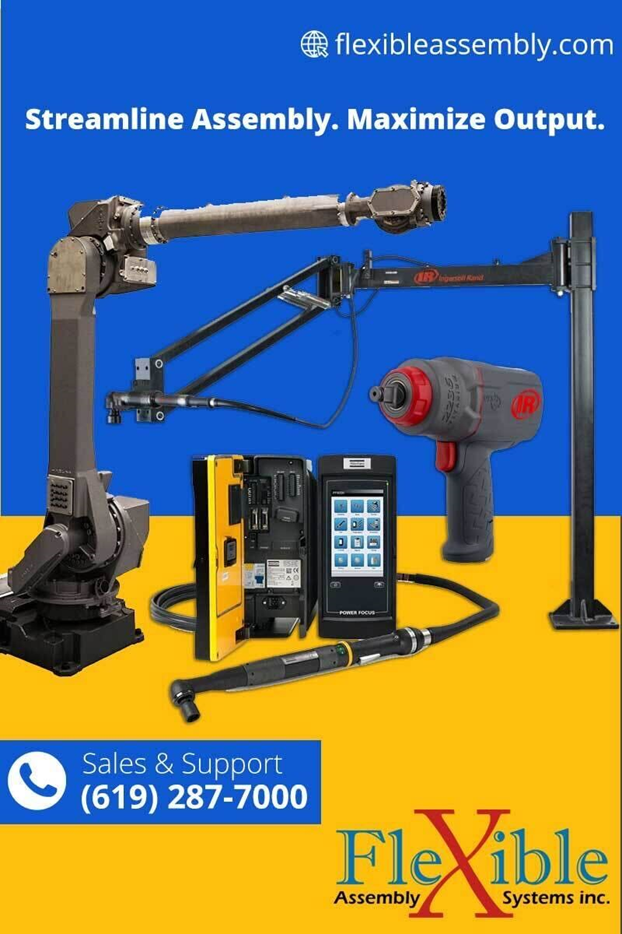Every assembly line needs to balance speed with worker health. Tightening screws by hand takes time and strains wrists. Picking fasteners from bins slows each cycle. Torque arms and screw feeders solve these issues together. They make stations safer and more productive. Operators work with less effort and set each joint to the correct force. You gain quality, repeatability, and output at the same time.
What Is a Torque Arm?
A torque arm guides a powered screwdriver or wrench. It absorbs the reaction force when the tool twists. Without it, that force travels into the operator’s arm. Over many cycles, wrists and shoulders grow sore. A torque arm holds the tool’s weight too. You position the tip at the joint, pull the trigger, and let the arm do the rest. No strain on muscles or joints. The tool stays in place, ready for the next fastener. Torque arms fit on carts, tables, or overhead rails. You adjust them to the height you need. No more lifting heavy tools.
Benefits of Torque Arms for Ergonomics
A torque arm cuts fatigue. Operators do not bear tool weight or twist force. They keep their wrist in a natural posture. That cut in effort matters over a full shift. You also avoid errors from tired hands. With a stable tool, each joint meets the set torque. Assembly quality rises and rejects fall. Safety improves too. Workers spend less time in awkward positions. They get home without aches or strains.
What Is a Screw Feeder?
A screw feeder stores and orients fasteners automatically. It moves each screw to a pick point just when the tool needs it. Feeders come in bowl, linear, or step types. A bowl feeder vibrates to guide screws up a spiral track. A linear unit pushes screws along a straight rail. A step feeder lifts them onto a platform at fixed spots. Sensors tell the system when to stop or refill. You avoid running out of parts in the middle of a batch.
Benefits of Screw Feeders for Efficiency
A screw feeder cuts pick time to zero. No more reaching and hunting for the next fastener. Each part arrives in the same position every time. That cut in motion saves seconds on each cycle. Over hundreds of joints, you regain hours of output. Screw feeders also reduce errors from misfeeds and human slip. Operators stay on task, not on parts management. The line flow stays smooth and steady.
Combining Torque Arms and Screw Feeders
When you pair torque arms with screw feeders, you build a true hands-free station. The feeder puts each fastener in place. The arm holds the tool steady and applies only the needed force. The operator simply presses the trigger and moves on. You avoid careless wrist actions and hand fatigue. Cycle times shrink and quality stays at the target. Workers stay in a safe posture from first screw to last.
Improving Worker Comfort and Safety
Assembly tasks often repeat the same motion hundreds of times. That leads to repetitive strain injuries. Torque arms remove the need to push or twist the tool. Screw feeders remove the need to bend or reach into trays. Operators stand or sit in a neutral stance. That cut in muscle tension lowers risk of injury. You also reduce breaks needed for rest. Workers feel less stress on shoulders, arms, and back.
Boosting Productivity and Output
Ergonomic setup does more than prevent pain. It raises throughput too. Torque arms speed tool positioning. Screw feeders keep the tool busy without pause. You shrink cycle time and hit hourly targets with ease. No more bottlenecks at the screw station. Operators can run two stations each with a feeder and arm. You maximize labor productivity without overloading any one person.
Maintaining Consistent Quality
Manual torque application varies by operator strength and focus. Screw tension may differ from shift to shift. With a torque arm housing an electric torque screwdriver, you set exact torque values. Each joint matches your spec. A screw feeder ensures the right part every cycle. No wrong screws or misaligned parts appear. Assembly quality stays high and rejects drop. That means less rework and fewer warranty issues.
Key Features to Look For
• Torque arm range and balance control. Choose a model that holds your tool weight and permits full torque range.
• Feeder capacity and feed rate. Match your screw size and cycle speed so you never run dry.
• Sensor integration. Parts-present and empty-bin signals keep your line from running off spec.
• Tool mounting options. A flexible mount lets you adjust height and reach easily.
• Control interface. Simple set points and clear indicators reduce operator errors.
Practical Tips for Station Setup
Place the feeder close to the tool tip. That keeps vibrations from disturbing nearby work. Mount the torque arm on a stable base. A cart with lockable wheels works well for mobile lines. Route air or power lines along the arm’s joints to avoid snags. Add a small tray for spent bit holders and tool change kits. Label each control clearly. A chart showing torque values and part numbers helps new operators. Regular checkups on calibration and sensor alignment keep things in tune.
Return on Investment
An ergonomic station costs more than a simple table and hand tools. Yet savings add up fast. You cut cycle times by seconds on each screw. Fewer breaks and lower injury risk save on labor and insurance costs. Reject rates fall and quality audits go smoother. Over months, these gains outweigh initial outlay. When you scale to multiple cells, the payback accelerates further. You get higher output, lower costs, and a happier team.
Industry Applications
Electronics plants fit small brackets with dozens of screws per unit. Torque arms handle delicate tools without strain, and feeders run small screws reliably. In automotive subassembly, high torque values and large fasteners need sturdy arms and high-capacity feeders. Appliance lines attach panels in long runs where stable torque and fast feeds matter. Medical device plants need clear records of tool calibration and zero operator fatigue. Across all these fields, the duo of torque arms and feeders lifts performance.
Addressing Common Concerns
Some managers worry about noise from bowl feeders. You can choose a linear feeder with low vibration and add a sound cover. Others cite space limits. A step feeder has a small footprint and works on a vertical plate. Tool balance on the arm feels tricky at first. Adjustable counterbalances and quick-lock joints let operators fine-tune the fit. Training on jam clearance and part reloading avoids line stops. With a plan for these issues, the station runs smoothly.
Why Choose Flexible Assembly Systems?
Flexible Assembly Systems brings deep expertise in ergonomic stations. We begin with a site survey to list part sizes, torque values, and cycle targets. From there, we match the best torque arm model and feeder type to your line. Our engineers handle installation and integration. We wire sensors, mount tools, and set control logic. Your team receives hands-on training for setup, jam clearance, and calibration checks. We offer service plans with regular site visits. When a sensor drifts or a tool needs a spare part, we respond fast. Our goal is to keep your station up and running at peak output.
Flexible Assembly Systems also helps with expansion projects. You copy a proven station design to new areas. Standard wiring and mounting templates speed setup. Shared parts lists keep spare kits lean. A central dashboard shows status of all feeders and torque arms. You know at a glance where to send maintenance. That unified view cuts downtime and raises overall productivity.
Final Thoughts
Torque arms and screw feeders work as a pair to give you the best of ergonomic design and process control. Reduced strain means healthier operators. Consistent feeds and exact torques mean higher quality. Faster cycles mean more output. Teams feel more confident and less tired. Flexible Assembly Systems stands ready to design, install, and support these systems. Bring your assembly line to a new level of safety and speed by adding torque tester and screw feeders to every station.
Read More Gorod








